
Chef April Bloomfield is a household name, but she isn't exactly famous for cooking vegetables.
Mention the British-born, NYC-based chef's name to anyone who cares about food and restaurants and they'll likely rave about the roquefort cheeseburger and the chicken liver toast at The Spotted Pig, or the lamb burger and the whole suckling pig at The Breslin. (And with good reason.) What they might not mention, though, is that she's also doing incredible things with vegetables.
With four restaurants in NYC and one in San Francisco, Bloomfield now splits her time between the two coasts. "What I love is being able to get off the plane and go straight to the farmers market," Bloomfield tells BuzzFeed Life. "Being able to see the contrast between the two coasts is awesome." Her new cookbook, A Girl and Her Greens, is filled with rustic, hearty vegetable recipes categorized by season. And don't worry — fussy, overly chef-y recipes aren't her thing.
"This is a very French Basque, peasant-y way to cook," she says of the recipe below, which is representative of the earthy, rustic food she's known for — a style she attributes in part to her time at The River Café in London. "When I started working at The River Café, I was amazed that I didn't have to, like, cut things into tiny squares. It was a revelation for me, and I was like, 'Oh my gosh, I feel like I've come home.'"
To make this vegetable-filled brunch dish, you'll cook onions in lots of olive oil until they're soft and super sweet, then add garlic, bell peppers, premade tomato sauce, and basil, let it all come together, then cook some eggs right on top.
Here is everything you'll need to make this breakfast:

1. If you have a cast-iron skillet or Dutch oven with a lid, you can cook these from start to finish on the stovetop. If not, preheat your oven to 400°F.
2. Before you start cutting your vegetables, make sure your knife is SHARP.

3. Thinly slice the red onion.

4. Heat 1/4 cup olive oil in a large cast-iron skillet or Dutch oven over medium heat.

CHEF'S TIP:
"If you add too much olive oil, the onions end up stewing, and if you have too little, they end up burning because there's nothing to buffer the onions and the pan," chef says. Also, it's best to use a heavy-bottomed pan, like cast iron, "because it helps pull out the sugars a little slower." If you use a thinner pan, the onions are more likely to burn because the heat is so close to the pan.
5. Once the oil is hot and starts to shimmer, add the onions.
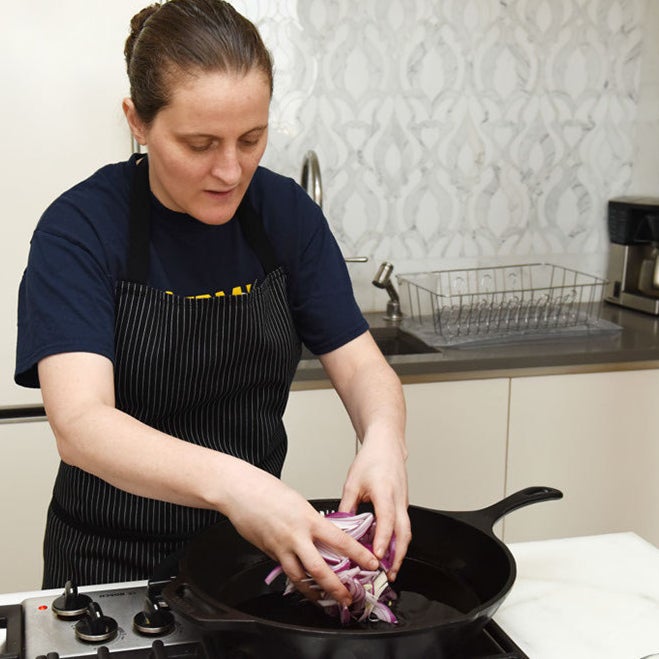

6. Spread them out and let them cook, stirring occasionally, until they're soft, 6-8 minutes.
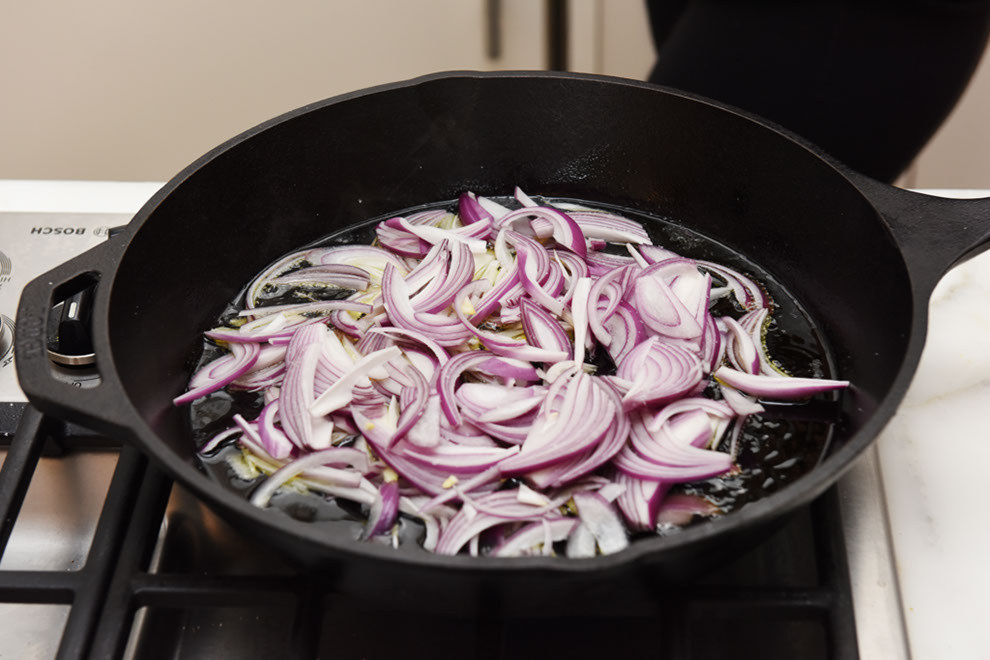
7. Meanwhile, use a vegetable peeler to peel the peppers.

You don't have to get every single bit of skin off. That would be massively stressful. Just get most of it.

8. Give the onions a good stir.
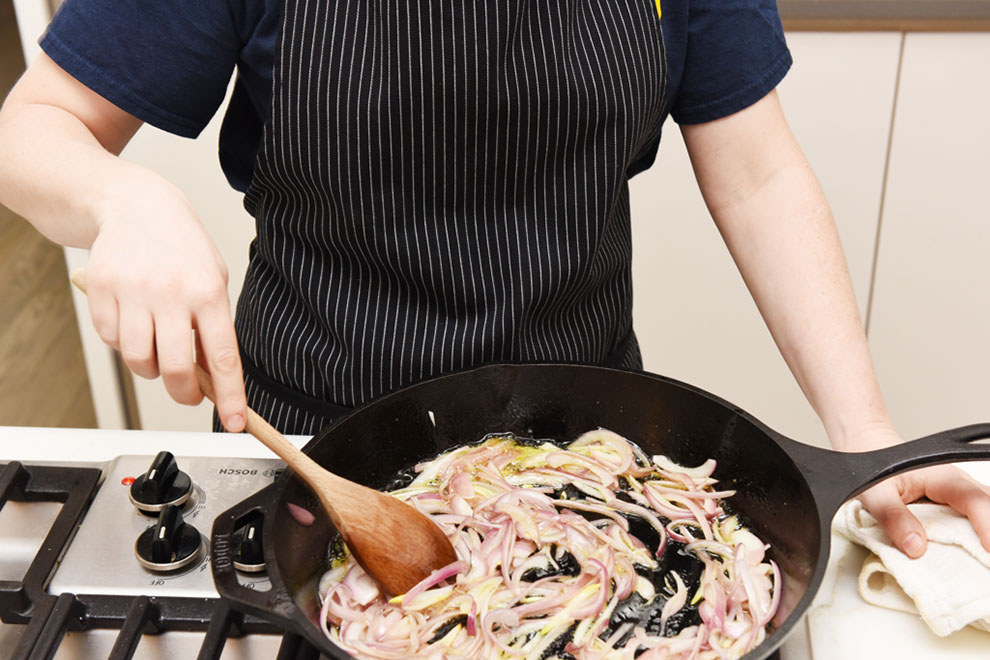
9. Cut the stems off of the peppers, then halve them lengthwise and cut out the seeds and white veins.

10. Slice the peppers into strips between 1/4 and 1/2 inch thick.

11. Thinly slice the garlic cloves.

12. Once the onions are pretty soft, push them to one side of the skillet, then add the garlic.

13. Cook the garlic for a couple of minutes, stirring it constantly.
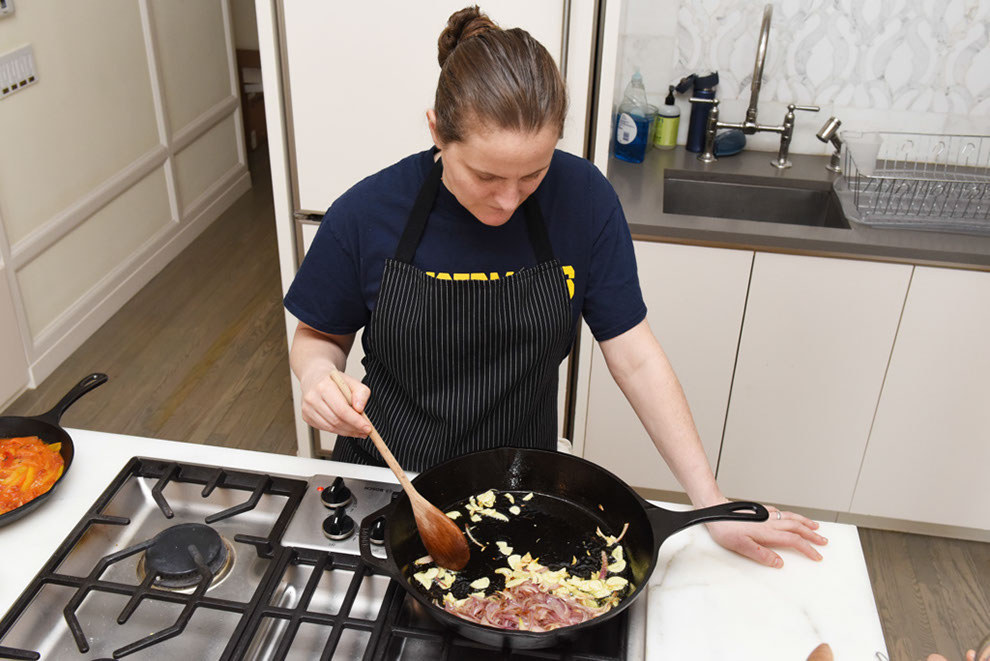
CHEF'S TIP:
"You can actually take garlic a little further than you're trained to do," chef says. "In French cooking, you just brown garlic very lightly, but you can actually cook it a little bit more to give the dish a little more warmth." Golden brown garlic is what you're going for, but don't worry if some bits darken just a little bit around the edges.
14. As soon as the garlic is soft, fragrant, and lightly browned, mix it in with the onions and cook, stirring occasionally, until the onions start to brown, 6-8 minutes.

15. Add the peppers all at once.

16. Season with salt and pepper.

17. Stir everything together and cook, stirring occasionally, until the peppers are tender but not mushy and the onions are starting to disintegrate.
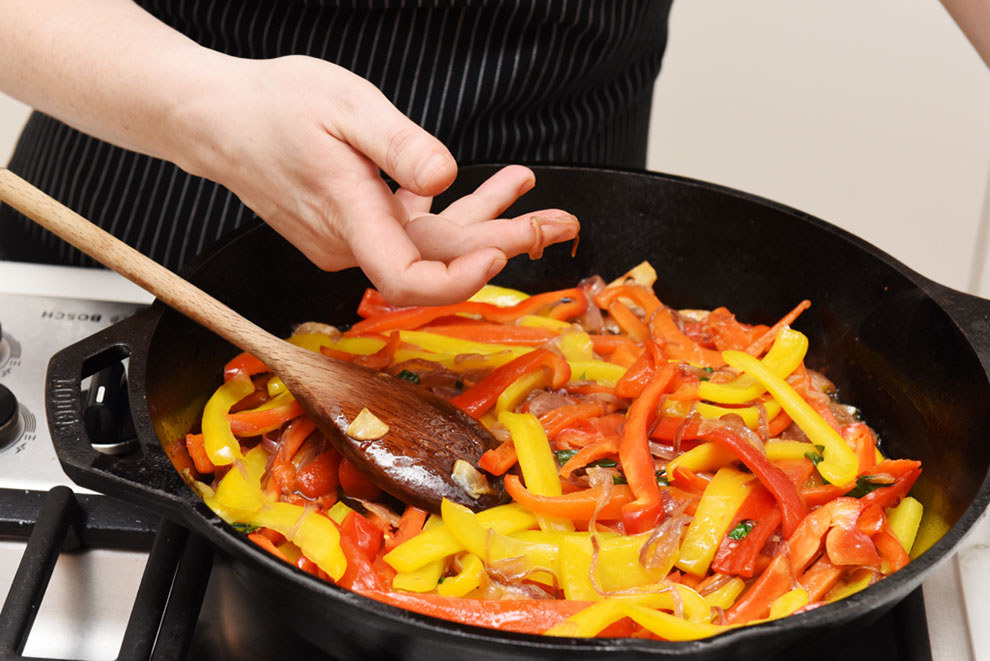
18. Turn the heat down to medium low and cook for about 5 more minutes, until the peppers are soft and super sweet.* Add the tomato sauce, and stir to combine.


*As everything cooks down and comes together, the natural sugars will get drawn out, making everything sweeter. Taste your food every once in a while as you're cooking, to make sure the seasoning is right and that you're cooking things long enough to really bring out the flavors.
19. Cook, stirring occasionally, for about 5 more minutes.

20. Once the peppers are soft and the sauce is finished, spread it out over the bottom of the skillet and crack the eggs over top.

21. Your sauce will be hot, so parts of the egg whites will start to cook immediately.

22. Put the skillet in the preheated oven.*

23. Bake in the oven for 5-8 minutes, until the egg whites are opaque but the yolks are still runny.

24. Sprinkle with a few crumbled pequín chiles, and serve immediately.
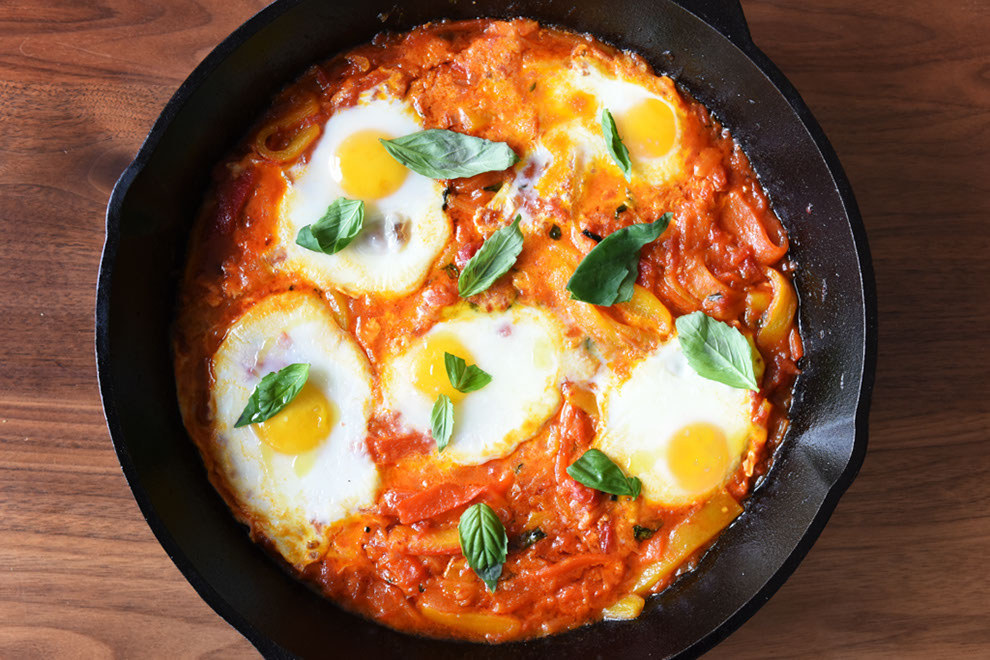
And no, we'd never heard of pequín chiles until chef brought them to the test kitchen. They're tiny (about the size of Tic Tacs) and pretty spicy, and they're sold dried.

25. Pile it on a nice piece of toast.
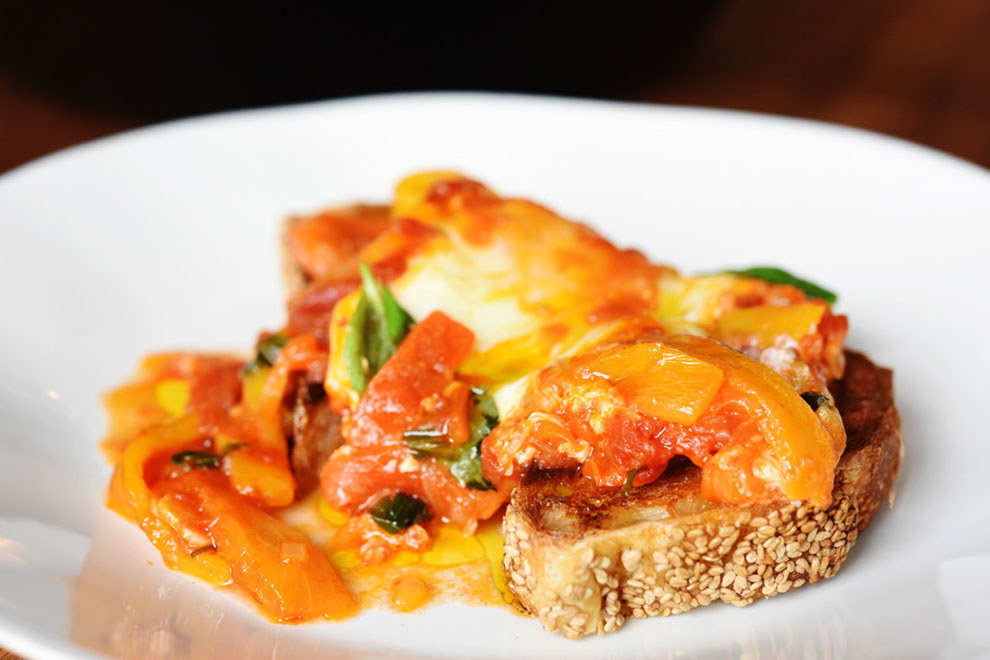
Eggs in Pipérade
Serves 2, as a main dish
For a truly laid-back morning, you can cook the pipérade (that's the olive oil, onion, pepper, and tomato sauce) in advance and keep it in the fridge, then just heat it up when you're ready.
Recipe by April Bloomfield
INGREDIENTS
2 pounds mixed yellow and red bell peppers (about 4 medium), halved lengthwise, seeded, stems removed
1/4 cup extra-virgin olive oil, plus more for finishing
1 medium red onion (about 1/2 pound), halved and thinly sliced
2 teaspoons sea salt (chef prefers Maldon), divided
2 medium garlic cloves, thinly sliced
1 cup Simple Tomato Sauce (recipe below) or another basic tomato sauce
1/4 cup basil leaves, roughly chopped, plus more for garnish
4 large eggs
5 dried pequín chiles, crumbled, or a few pinches of red pepper flakes
PREPARATION
1. Use a vegetable peeler to peel the skin from the peppers, then slice them into long strips somewhere between 1/4 and 1/2 inch thick.
2. Heat olive oil in a large Dutch oven or cast-iron skillet over medium heat until it's shimmering. Add the sliced onion and 1 teaspoon sea salt. Cook, stirring occasionally, until the onion has softened, about 5 minutes. Push the onion to one side of the skillet and add the garlic to the oil. Cook, stirring the garlic occasionally but not the onions, until the garlic turns light golden and smells toasty, about 3 minutes. Stir it all together and cook, stirring now and then, until the onion is lightly browned and very soft, 6-8 minutes.
3. Add the peppers to the pot along with the remaining 1 teaspoon sea salt and cook, stirring often and scraping the bottom after a while, until the onions start to disintegrate and the peppers are tender but not at all mushy, about 10 minutes.
4. Reduce the heat to medium-low and keep cooking, stirring and scraping, until the pot gets lovely brown sticky stuff on it and the peppers get a bit softer, about 5 minutes more. Have a taste. The peppers should be really sweet and have a meaty texture. Stir in the tomato sauce and cook at a good sizzle until it thickens slightly, a few minutes. Stir in 1/2 cup of water and the basil and let the mixture return to a simmer. Season to taste with additional sea salt, if you want.
5. Crack the eggs into the pot, spread out over top of the sauce, cover with a lid, and reduce the heat to low. Cook until the eggs are to your liking, 4-5 minutes for nice runny yolks. Sprinkle the chiles on the yolks, scatter on the rest of the basil, drizzle on some olive oil, and serve immediately. Preferably with nice, crusty bread.
Simple Tomato Sauce
Makes about 2 cups
Recipe by April Bloomfield
INGREDIENTS
2 28-ounce cans whole tomatoes, drained, trimmed*
4 tablespoons extra-virgin olive oil
1 medium red onion (about 1/2 pound), finely diced
1 1/2 teaspoons sea salt (chef prefers Maldon), divided
2 medium garlic cloves, thinly sliced
1/4 cup basil leaves, roughly chopped at the last minute
*Chef's note on using canned tomatoes: "First, drain and discard the liquid they come in, which I find tastes artificially sweet and salty. Second, trim any yellowish patches, straggling skin, and the tough core from each tomato."
PREPARATION
1. Working with one at a time, hold the tomatoes over a bowl and use a finger to poke through the flesh and squeeze gently so the liquid inside spills into the bowl. Strain and reserve the liquid, and roughly chop the tomatoes.
2. Heat 3 tablespoons of the oil in a medium pot over medium-high heat until it shimmers. Add the onion and 1 teaspoon sea salt. Lower the heat to medium and cook the onions at a steady sizzle, stirring occasionally, until they go translucent, 4-5 minutes.
3. Push the onion to one side of the pot and add the garlic to the oil. Pay especially close attention to the garlic as you cook, stirring the garlic occasionally but not the onion, until the slices turn a light golden color and smell toasty, about 3 minutes. Stir it all together with the onion and cook, stirring occasionally, until the slices turn golden with slightly darker edges, about 5 minutes more. Just when you start to freak out that the edges might begin to burn, stir in the tomatoes (not the liquid just yet).
4. Raise the heat to medium-high and let the mixture simmer rapidly, stirring and breaking up the tomatoes a bit, until it looks less like separate bits and more like one sauce, about 3 minutes. Add the tomato liquid, bring it to a vigorous simmer, then lower the heat to maintain a gentle simmer. Cook, stirring now and then, until the sauce thickens slightly and the flavors have a chance to mingle, about 30 minutes.
5. Stir in the basil, the remaining 1 tablespoon of oil, and the remaining 1/2 teaspoon sea salt. Raise the heat to bring the sauce to a proper simmer and cook until it thickens slightly and you can taste the basil a bit more, about 5 minutes.
6. Use the sauce right away or let it cool and store it in an airtight container in the fridge for up to 3 days.
Love how perfect and simple this recipe is? Check out A Girl and Her Greens for more very smart, very delicious ways to cook with vegetables.

Follow BuzzFeed Food on Instagram for more #BuzzFeedBreakfast dishes and other awesome food stuff.

